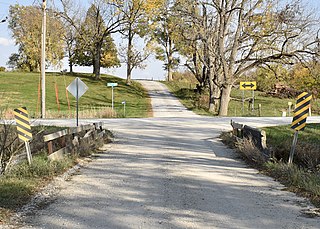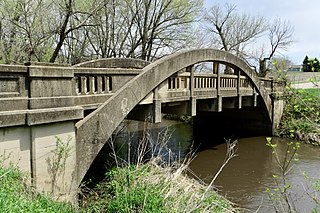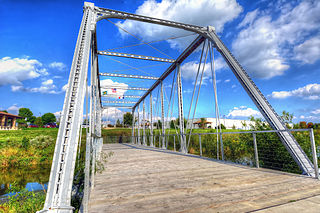
James Barney Marsh was an American engineer and bridge designer. He patented a new design for arch bridges. Marsh gave Archie Alexander, the first African-American to graduate as an engineer from Iowa State University, his first job. Marsh worked in the bridge building business for over 50 years, and several of his bridges are listed in the National Register of Historic Places.

The Lincoln Highway Bridge is located in Tama, Iowa, United States, along the historic Lincoln Highway. The Steel stringer bridge was built in 1914, and it was listed on the National Register of Historic Places in 1978. It spans Mud Creek for 22 feet (6.7 m) with a width of 24 feet (7.3 m). The bridge is noteworthy for its distinctive railings. They are 3.33 feet (1.01 m) high, and feature the words "Lincoln Highway" in concrete. Local boosters of the Lincoln Highway paid for the railings as a way of promoting the roadway. The bridge was designed by the Iowa Highway Commission and built by Paul N. Kingsley, a contractor from Strawberry Point, Iowa.

The Bertram Bridge, also known as the Ely Street Bridge, was a historic structure located near the town of Bertram in rural Linn County, Iowa, United States. The metal 5-panel pinned Pratt through truss bridge was built in 1891. It was designed by the J.E. Jayne and Son Bridge Company of Iowa City. The bridge had two main spans and two approach spans. The whole structure was 208 feet (63 m) and the roadway was 13.5 feet (4 m) wide. The bridge was listed on the National Register of Historic Places in 1998 as a part of the Highway Bridges of Iowa MPS.

The Calamus Creek Bridge near Maxwell, Iowa is a concrete Luten arch bridge constructed in 1905. It was built by N. M. Stark and Company for a cost of $900. It has a 25-foot (7.6 m) single span and a total length of 45 feet (14 m).

The Vine Street Bridge in West Union, Iowa brings South Vine St. over Otter Creek. It is a concrete Luten arch bridge built in 1910 by N.M. Stark & Co. It was listed on the National Register of Historic Places in 1998.

CM and StP Railroad Underpass is a historic structure located southwest of Washington, Iowa, United States. It was listed on the National Register of Historic Places in 1998. The Warren deck truss bridge is a rare example of this type of bridge in Iowa, and the oldest still in existence. Given the relatively flat nature of Iowa's rivers and streams this bridge type was rarely built in the state, and was mostly built for railroad use. This bridge, completed in 1903 by the Chicago, Milwaukee, St. Paul & Pacific Railroad, crosses a county highway bridge and the west fork of Crooked Creek.
The Toledo Bridge was located in Toledo, Iowa, United States. It spanned Deer Creek for 124 feet (38 m). The Clinton Bridge and Iron Works of Clinton, Iowa built a single-span, pin-connected Pratt truss in 1912. The following year it became part of the Lincoln Highway route. It was listed on the National Register of Historic Places in 1998. The historic span was replaced by a concrete span in 2006, and removed from the National Register in 2009.

Beaver Creek Bridge is located northwest of Ogden, Iowa, United States. It spans Beaver Creek for 52 feet (16 m). The Marsh arch bridge was designed by Des Moines engineer James B. Marsh, and built by the N.E. Marsh & Son Construction Company of Des Moines in 1919. After it was completed it carried traffic on the Lincoln Highway. The bridge was listed on the National Register of Historic Places in 1998.

Big Creek Bridge 2 is located northeast of Madrid, Iowa, United States. It spans Big Creek for 53 feet (16 m). The Marsh arch bridge was designed by Des Moines engineer James B. Marsh in February 1917. The contract to build the structure was awarded in April of the same year to the N.E. Marsh & Son Construction Company of Des Moines for $3,170. It was completed later in 1917. The bridge was listed on the National Register of Historic Places in 1998.
The Storm Creek Bridge is located northeast of Carroll, Iowa, United States. The 64-foot (20 m) span carries traffic on Phoenix Avenue over Storm Creek. This bridge was one of 15 similar spans that Carroll County had built in 1913. The county board of supervisors contracted with the Standard Bridge Company of Omaha to build the Warren pony truss structures that were designed by the Iowa State Highway Commission (ISHC). They were supported by a timber substructure. The bridges became the prototype of what would become the ISHC's standard design. Standard Bridge was paid $29,174 to build all the bridges, which included the costs for this bridge at $2,026. It was listed on the National Register of Historic Places in 1998.
The Storm Creek Bridge 2 is located east of Carroll, Iowa, United States. The 57-foot (17 m) span carries traffic on 190th Street over Storm Creek. This bridge was one of 15 similar spans that Carroll County had built in 1913. The county board of supervisors contracted with the Standard Bridge Company of Omaha to build the Warren pony truss structures that were designed by the Iowa State Highway Commission (ISHC). They were supported by a timber substructure. The bridges became the prototype of what would become the ISHC's standard design. Standard Bridge was paid $29,174 to build all the bridges, which included the costs for this bridge at $1,987. It was listed on the National Register of Historic Places in 1998.
The Shellsburg Bridge is a historic structure located in Shellsburg, Iowa, United States. It spans Bear Creek for 64 feet (20 m). In April 1915 the Benton County Board of Supervisors contracted with Alfred Vinall to build the new bridge near Shellsburg's downtown area. He used a special design by the Iowa State Highway Commission (ISHC), and completed the project in late 1915 for $6,081.06. The ISHC designed plain bridges for its rural spans, but because this span is in town it features decorative elements: bichrome concrete detailing, molded concrete balustrades, and incised spandrel panels. The bridge was listed on the National Register of Historic Places in 1998.

The Steyer Bridge is a historic structure located on the west side of Decorah, Iowa, United States. This is one of the few stone arch bridges that continue to exist in Iowa. It was constructed by local stonemason Michael Steyer over Twin Springs Creek in 1875. Steyer emigrated from Germany in 1867, and settled in Decorah. His brother Joseph was the proprietor of the Steyer Opera House in town. Compared to other stone bridges in the state, this one is less sophisticated and is a good example of vernacular engineering. It is a small structure that consists of a single arch that is formed by rough-cut limestone voussoirs. The keystone is a block of dressed limestone with Steyer's name and the date "1875" carved on it. The spandrels and the walls that form the foundation for the approaches to the bridge consist of coursed rubble limestone. The base of the walls and the lower edges of the arch were reinforced with concrete in the 1970s. The concrete bridge deck is edged with wooden posts. When U.S. Route 52 was relocated to this area in the early 1970s, the Steyer Bridge was scheduled to be removed, but local protests saved it and the highway bridge built over it. The bridge listed on the National Register of Historic Places in 1983.
Otter Creek Bridge is a historic structure located northwest of Oelwein, Iowa, United States. It spans Otter Creek for 86 feet (26 m). In July 1917, the Fayette County Board of Supervisors choose this bridge design for a concrete through girder bridge from the Iowa State Highway Commission, and put the project out to bid. When no one bid on the job they decided to use day laborers to build the bridge. It was completed later in 1917 for $5,153.88. The bridge was listed on the National Register of Historic Places in 1998.
Stoe Creek Bridge was a historic structure located northwest of Oelwein, Iowa, United States. It spanned Stoe Creek for 38 feet (12 m). In June and July 1913, the Fayette County Board of Supervisors awarded contracts for several small bridges in the county. The Iowa State Highway Commission designed this single span bridge that was built by N.M. Stark and Company of Des Moines. It was completed in 1914 for $1,654. The bridge was listed on the National Register of Historic Places in 1998. It was replaced in 2007.

The Dunleith and Dubuque Bridge, also known as the White Water Creek Bridge and the Bergfeld Recreation Area Bridge, is a historic structure located in Dubuque, Iowa, United States. This span was part of a seven-span approach to one of the first bridges constructed over the Mississippi River. It was part of a railroad bridge that connected Dubuque with Dunleith, Illinois, now known as East Dubuque. The bridge was fabricated by the Keystone Bridge Company of Pittsburgh, Pennsylvania. Andrew Carnegie himself traveled to Dubuque to advocate for his company to build the bridge. The bridge was erected by Reynolds, Saulpaugh and Company of Rock Island, Illinois. The approach, of which this iron truss was a part, was completed in 1872. It was used by the Illinois Central and other railroads.

East Indian Creek Bridge is a historic structure located southeast of Nevada, Iowa, United States. It spans East Indian Creek for 78 feet (24 m). N.M. Stark and Company of Des Moines started building bridges for Story County beginning in 1902, and then they held an exclusive contract until 1913 when the Iowa Legislature banned the practice. Stark constructed this concrete Luten arch structure in 1912 for $4,462 as part of a multi-bridge contract. This was the longest concrete arch built by Stark in Story County. It was listed on the National Register of Historic Places in 1998.
The Fish Creek Bridge is a historic structure that was originally located east of Salem, Iowa, United States. The span carried Hickory Road over Fish Creek for 50 feet (15 m). It is a small-scale, wrought-iron bridge that the Henry County Board of Supervisors bought from the George E. King Bridge Company of Des Moines in 1893 for $410.80. It was believed to have been fabricated by their parent company, King Iron Bridge Company of Cleveland, and assembled by local laborers. Its historical significance derived from its being an uncommon variant of the Pratt truss. It was listed on the National Register of Historic Places in 1998. Subsequently, the bridge has been replaced at its original location, and the historic structure was moved to Oakland Mills Park.

The Herrold Bridge is a historic structure located near the unincorporated community of Herrold, Iowa, United States. It carried a gravel road for 156 feet (48 m) over Beaver Creek. Completed in 1921, this concrete cantilevered deck girder bridge replaced an earlier timber pile structure. It was designed by the Iowa State Highway Commission the previous year, and the Polk County Board of Supervisors awarded the construction contract to Ben Cole of Ames. The total cost of construction was $24,283.36. The bridge features three arched concrete deck girder spans that are cantilevered from concrete abutments and piers. It is considered one of the most technologically significant of Iowa's concrete girder bridges. The bridge was listed on the National Register of Historic Places in 1998. While it remains in place, the Herrold Bridge was replaced by a newer span slightly downstream.

Big Creek Bridge was a historic structure located northeast of Madrid, Iowa, United States. It spanned Big Creek for 43 feet (13 m). The Marsh arch bridge was designed by Des Moines engineer James B. Marsh. It was completed in 1916. The bridge was listed on the National Register of Historic Places in 1998. The historic span was replaced by a new bridge in 2004.
















